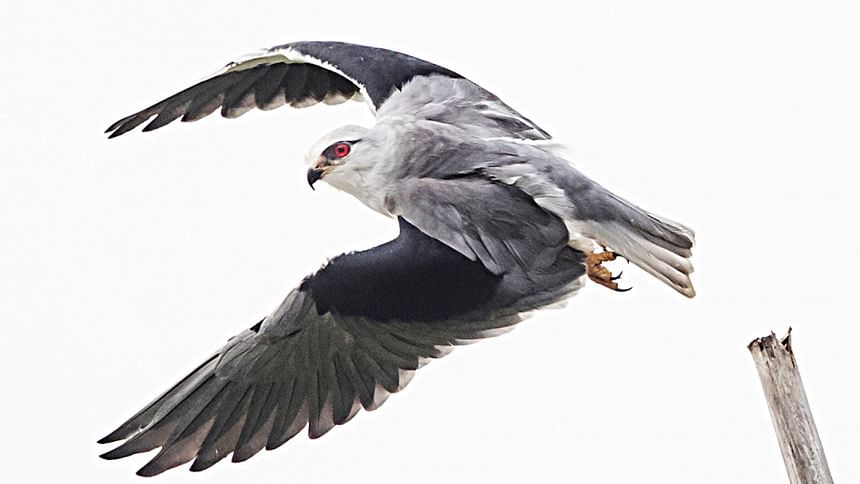Black-shouldered Kite

One morning I was looking for birds in the open spaces of Purbachol. The spot I chose yielded nothing, so at around 10:30 I left and started driving around. I stopped at a promising place: a paddyfield, swamps and scattered bamboo groves with little construction activity and no people. I checked the trees and bushes carefully but found only Shaliks and Bulbuls. Almost by accident I noticed the bird in the sky. The backlight had turned it into a faint silhouette against the bright late morning light. Wingtips rapidly fluttering, it was hovering above one spot like a helicopter. Seconds later it dived to the ground. Talons out, it closed in on a bush only to come up empty. It repeated the hovering-diving several times without luck before flying off to test its luck elsewhere.
The bird was a Black-shouldered Kite (Kathua Cheel), the smallest of three species of Kites found in Bangladesh. About three-quarters the size of a house crow, it is light grey with pointed wings and a large black patch on its shoulders. A black border runs around its eyes and extends to the back of the head, giving it a dramatic look. But its biggest highlight is the eyes: blood-red, standing out sharply if improbably against the monochromatic body.
I drove around looking for the bird and eventually found it (or possibly another of its species) perched on top of a bamboo in a small grove. It seemed in no hurry, periodically scanning the surrounding ground looking for food. The rest of the time it preened its feathers. Since feathers are critical for flight, birds expend much effort in keeping them in prime shape. This Kite was no exception. It followed a methodical and meticulous process, starting with the primary flight feathers at the edge of each wing. Using its beak it cleaned out and aligned the filaments of each feather. Then it patiently went over other feathers on its body, twisting its head around to reach those in its back.
Black-winged Kites are year-round residents of Bangladesh. They build their nests on smaller trees - a loose and untidy collection of twigs, similar to other birds of prey. The female lays 3-6 eggs in a clutch and the male rears the chicks.
The other two kites of Bangladesh, Brahminy Kite and Black Kite, are much larger. But they are lazy when it comes to food, preferring scavenging over hunting. In flight, they conserve energy by using thermals to glide whenever possible. The Black-winged Kite, on the other hand, is every inch a hunter. It flies vigorously and catches field rats, mice, frogs, snakes, lizards, young birds as well as a variety of insects. Its hunting tools are the sharp talons at its feet. By hovering it can search and track prey before diving in with the talons for the kill. It is territorial and forcefully chases away any rival bird from the area it has claimed.
So now you know why my heart skips a beat every time I see a Black-winged Kite. It signals drama and excitement.
www.facebook.com/ikabirphotographs or follow "ihtishamkabir" on Instagram.

 For all latest news, follow The Daily Star's Google News channel.
For all latest news, follow The Daily Star's Google News channel. 



Comments